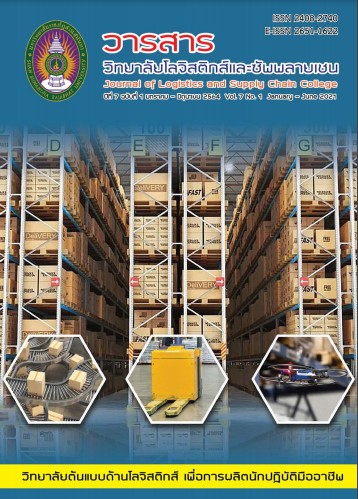Increasing Efficiency of Warehouse Management: A Case Study of Second Hand Shoes Warehouse
Keywords:
Increase efficiency, Warehouse management, Reduce the search timeAbstract
The purposes of this research are 1) to reduce the time to find the products in the warehouse and 2) to increase the efficiency of product storage in warehouse. Experimental Research was applied in this study. Populations in the research were the staffs operating in warehouse section and the sample group used the 5 staffs of this section as a tool. Testing was performed by counting operating time for finding products before and after improvement. By preliminary study, it was found that the major problems from unsorting of shoe types and no recording of shoes quantities in the warehouse resulting in products mixing confusingly. In order to solve the problems, the fishbone diagram was introduced, the results showed that 23.3% of the problems came from product finding. Then, the stock card method was applied to improve the process of finding and stocking products for monitoring type and quantities of the shoes. Furthermore, the activities based sorting and the fixed location system methods were adopted in the warehouse for sorting the shoes in appropriate and fixed locations. The best seller shoes were placed near the door for easily finding. The staffs were trained for the fixed location storage technique. After system improvement, the time for product finding was checked for comparing with before. The results showed that the average time for finding the shoes was reduce about 37.7% or 5.29 min/order. From this study, it is recommended that these methods should be applied for managing warehouse in the future.
References
กฤษณ์ เดชอมร. (2557). การปรับปรุงประสิทธิภาพการจัดการคลังสินค้า กรณีศึกษา โรงงานผลิต แป้งมันสำปะหลังแปรรูป. ปริญญาบริหารธุรกิจมหาบัณฑิต สาขาวิชาการจัดการโลจิสติกส์ บัณฑิตวิทยาลัย, มหาวิทยาลัยหอการค้าไทย.
เกียรติพงษ์ อุดมธนะธีระ. (2561). WIM การวิเคราะห์จัดกลุ่มด้วยระบบ ABC Analysis. ค้นเมื่อ 18 ธันวาคม 2563, จาก:https://www.iok2u.com/index.php/article/e-book/249-abc-analysis-abc.
ชุติมา ศักดาพิสุทธิ์. 2557. การศึกษาแนวทางการเพิ่มประสิทธิภาพการจัดการคลังสินค้า กรณีศึกษา บริษัท KPK จำกัด. วิทยานิพนธ์ปริญญามหาบัณฑิต สาขาวิชาการจัดการโลจิสติกส์ มหาวิทยาลัยหอการค้าไทย.
ธัญวรรณ มาศวิวัฒน์. (2559). การกำหนดเวลามาตรฐานในอุตสาหกรรมผลิตชิ้นส่วนเลนส์โดยใช้เทคนิค most. งานค้นคว้าอิสระวิศวกรรมศาสตรมหาบัณฑิต สาขาวิชาการพัฒนางานอุตสาหกรรม, คณะวิศวกรรมศาสตร์, มหาวิทยาลัยธรรมศาสตร์.
นราวิชญ์ มงคลรัชดารมย์ และรวินกานต์ ศรีนนท์. (2560). การประชุมสัมมนาเชิงวิชาการด้านการจัดการโลจิสติกส์และโซ่อุปทานครั้งที่ 17, คณะวิศวกรรมศาสตร์ มหาวิทยาลัยสงขลานครินทร์.
วรพจน์ บุษราคัมวดี. (2556). การจัดการคลังสินค้า. ปทุมธานี: ศูนย์การเรียนรู้การผลิตและการจัดการธุรกิจสิ่งพิมพ์ดิจิตอล, 60-63.
วิยดา สังโชติ. (2558). การเพิ่มประสิทธิภาพการจัดการคลังสินค้าสำเร็จรูป กรณีศึกษาโรงงานผลิตกระดาษเคลื่อนซิลิโคน. งานนิพนธ์ปริญญาวิทยาศาสตร์มหาบัณฑิต สาขาวิชาการจัดการโลจิสติกส์และโซ่อุปทาน, บัณฑิตวิทยาลัย, มหาวิทยาลัยบูรพา.
สิมิลัน เทคโนโลยี. (2561). กลยุทธ์การจัดเก็บสินค้า (Storage Stratege) ในคลังสินค้า. ค้นเมื่อ 18 ธันวาคม 2563, จาก: http://www.similantechnology.com/news&article/Storage-Strategy.html.
Flow account. (2562). การจัดการสินค้าคงเหลือ เทคนิคบริหารสต๊อกสินค้าอย่างง่าย. ค้นเมื่อ 19 ธันวาคม 2563, จาก: https://flowaccount.com/blog/การจัดการสินค้าคงเหลือ/.
Mersereau, A. J. (2015). Demand estimation from censored observations with inventory record inaccuracy. Manufacturing & Service Operations Management, 17(3), 335–349.



